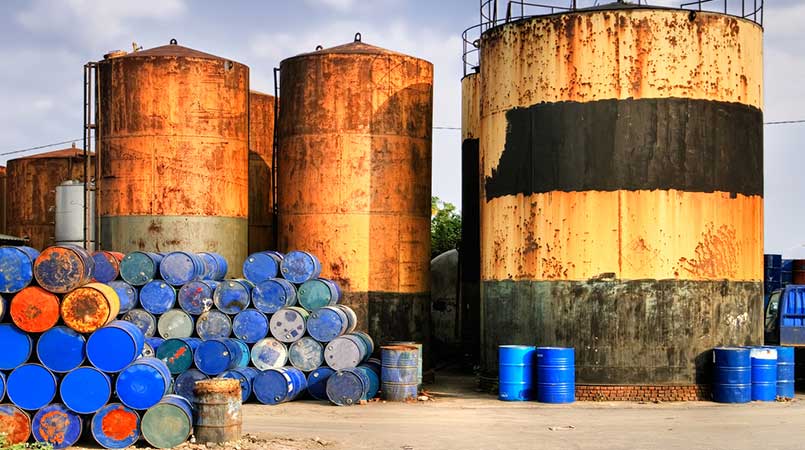The extreme dangers of improper hazardous chemical storage are far too often overlooked, yet time after time, we are given shocking reminders of their deadly and destructive toll. As we continue to provide news and information around workplace safety during National Safety Month, we must not overlook two of the largest hazardous chemical disasters in recent memory — the 2013 explosion at the West Fertilizer Company (WFC) in West, Texas which killed 15 and injured 160, and the 2015 Ruihai International Logistics warehouse explosion in Tianjin, China that killed 173 people, injured 720, and displaced thousands more — both of which were caused by unsafe, improper chemical storage.
Hazardous Chemical Storage form West Fertilizer Company
The key finding in the U.S. Chemical Safety Board’s investigation of the WFC explosion determined that while arson likely played a role in the blast, it was the storage of 40-60 tons of fertilizer-grade ammonium nitrate (FGAN) in open wooden bins and the proximity of combustible materials (including the bins themselves) that was the primary factor in the ignition and subsequent detonation of the chemicals stored within the facility.
Safety data sheets (SDSs) for FGAN specifically indicate proper chemical storage in sealed containers away from combustible materials, and in a cool and well-ventilated space. Had the FGAN at WFC been properly stored, the first responders may have been able to extinguish the primary structure fire, and their lives would have been spared.
Improper Hazardous Chemical Storage in Tianjin
An investigation by the Chinese government released in February 2016 determined the initial cause of the Tianjin explosion to be the vaporization and subsequent auto-ignition of nitrocellulose that was exposed to excessive heat while in storage. When first responders attempted to extinguish the initial fires, they were unaware that the 500,000 square-foot facility also stored massive quantities of potential explosives including calcium carbide, potassium nitrate, ammonium nitrate, sodium nitrate, and as much as 700 tonnes (771.6 tons) of sodium cyanide.
When mixed with water, calcium carbide produces extremely flammable acetylene gas. Had first responders been aware of the chemical inventory in the warehouse, they would not have doused the fire with water, which combined with the calcium carbide to produce highly flammable acetylene gas. The gas ignited, resulting in two explosions — the second of which had the explosive energy of 0.45 kilotons of TNT. The presence of sodium cyanide, among other toxics in the facility, resulted in an ongoing ecological disaster that could have profound, lasting effects on the population and environment in the port of Tianjin.
Lessons Learned
The human and environmental toll, not to mention the financial costs of these incidents could likely have been prevented through effective training and implementation of proper hazardous chemical storage procedures. Access to accurate, up-to-date chemical SDSs, a well-documented inventory including the locations and quantities of hazardous chemicals within the facility, and awareness of these chemical inventories on the part of first responders are three essential precautions that could have helped limit the extent of the disasters in Tianjin and West, Texas.
VelocityEHS chemical management software from VelocityEHS is an easy way to provide your employees with mobile access to the most up-to-date SDS information available so they can be aware of the chemical hazards in your facility, use proper storage and handling techniques, and proactively identify risks to the health and safety of your workplace. Our easy-to-use chemical inventory mapping tool allows you to upload your floor plan and create a virtual map of the hazardous chemicals in your facility, identifying their quantity and location down to the individual container and precisely coordinating their storage to ensure they are kept under safe conditions.
On their own, these tools provide you with new levels of visibility into your organization’s chemical footprint. Now imagine giving your local fire department the ability to pull up a real-time view of your chemical inventory on any mobile device while responding to an incident at your facility. Or better yet, being able to coordinate their response strategy well before an event ever occurs. VelocityEHS’ Plan 1 First Responder Share Service gives emergency responders real-time access to your chemical inventory, floor plans and SDS information via the cloud, making it easier to develop a response strategy that accounts for the hazardous chemicals in your facility and helping to keep your community safe.
We think it’s such an important tool, Plan1 is included at no extra cost as part of your VelocityEHS HQ and HQ RegXR account.
In support of National Safety Month, VelocityEHS is sharing tips and information throughout the month of June to help EHS professionals strengthen their commitment to worker safety. Follow along on Twitter and LinkedIn for more information.
